Punjab region
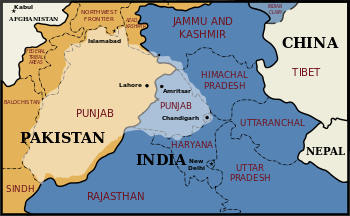
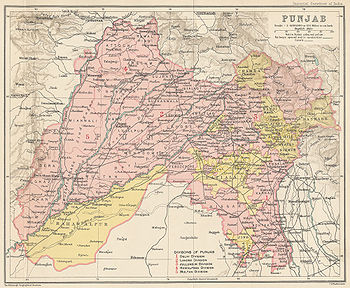
The Punjab (pronounced /ˈpʌndʒɑːb/ or /ˈpʌndʒæb/; Punjabi: ਪੰਜਾਬ, پنجاب, Urdu: پنجاب, Hindi: पंजाब), also spelled Panjab (Persian: پنجاب, panj-āb, "five waters"),[1] is a cultural region straddling the border between India and Pakistan and comprising the Indian state of Punjab and the Pakistani province of Punjab.[2] The "five waters" are the Jhelum, the Chenab, the Ravi, the Sutlej, and the Beas. All are tributaries of the Indus River, the Jhelum being the largest. Punjab has a long history and rich cultural heritage. The people of the Punjab are called Punjabis and their language is also called Punjabi. The main religions of the Punjab region are Islam, Sikhism and Hinduism.
The area now known as the Greater Punjab comprises what were once vast territories of West Pakistan and northern western India. The bigger section of the Punjab at about 60% lies within Pakistan and 40% within Republic of India where it has been further been divided into three states.
The region is populated mostly by Indo-Aryan speakers. Of these people there are different religious groups such as Muslims, Sikhs, Christians, Jains, Buddhists and Hindus. It has also been inhabited by Greeks, Persians, Arabs, Turks, Mughals, Afghans, Balochis, and British. In 1947, it was partitioned between British India's successor states with three out of the five rivers going to Pakistan and the remaining two rivers were allotted to India.
The Pakistani Punjab now comprises the most densely populated province in Pakistan. In India, the Government further sub-divided Punjab into the modern Indian states of Punjab, Haryana, Himachal Pradesh and Delhi. The Pakistani part of the region West Punjab covers an area of 205,344 square kilometers (79,284 square miles), whereas the Indian State of Punjab is 50,362 square kilometers (19,445 square miles). Besides the Indian Punjab, the region also includes the areas of Jammu region and Himachal and Haryana states of India that were created out of East Punjab in 1966. The populations of the region are divided as 86,084,000 (2005) in West Punjab (Pakistan) and 24,289,296 (2000) in the present-day State of (East) Punjab (India). Punjabi is spoken by (approximately) 60% of the entire population in Pakistan mainly in the Panjab province, making it the most spoken language in Pakistan, and 92.2% in Indian Punjab. (3% of overall Indian population).[3] The capital city of undivided Punjab was Lahore, which now sits close to the partition line as the capital of West Punjab; while the capital of East Punjab is Chandigarh; which is five hours from Lahore.[4] Indian Punjab uses the Gurmukhi script, while Pakistani Punjab uses the Shahmukhi script.
Contents |
Grammar
The word 'Punjab' itself is a noun and could be used without the definite article "the" preceding it. Some academics, however, have recently broken with this and have begun to call it "the Punjab" rather than simply "Punjab," whenever it is a noun in all cases.
History
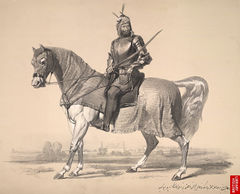
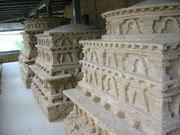
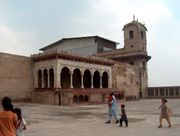
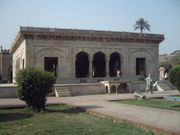

The Punjabi region, like most of North India, Iran, Afghanistan, and Pakistan, has a historical and cultural link to Indo-Aryan heritage identity. As a result of numerous invasions, many ethnic groups and religions make up the cultural heritage of the Punjab.
In prehistoric times, one of the earliest known cultures of South Asia, the Harappa civilization, was located in the Punjab.
The epic battles described in the Mahabharata were fought in modern-day Harayana and historic Punjab. The Gandharas, Kambojas, Trigartas, Andhra, Pauravas, Bahlikas (Bactrian settlers of Punjab), Yaudheyas and others sided with the Kauravas in the great battle fought at Kurukshetra.[5] According to Dr Fauja Singh and Dr L. M. Joshi: "There is no doubt that the Kambojas, Daradas, Kaikayas, Andhra, Pauravas, Yaudheyas, Malavas, Saindhavas and Kurus had jointly contributed to the heroic tradition and composite culture of ancient Punjab".[6]
In 326 BCE, Alexander the Great invaded the Punjab from the north and incorporated it into his empire. His armies entered the region via the Hindu Kush in northwest Pakistan and his rule extended up to the city of Sagala (modern-day Sialkot) in northeast Pakistan. In 305 BCE the area was divided between the Maurya Empire and the Greco-Bactrian Kingdom. In a long line of succeeding rulers of the area, Chandragupta Maurya and Ashoka the Great stand out as the most renowned. The Maurya presence in the area was then consolidated in the Indo-Greek Kingdom in 180 BCE. Menander I Soter "The Saviour" (known as Milinda in Indian sources) is the most renowned leader of the era. Greek ruling came to an end around 12 BCE, after several invasions by the Yuezhi and the Scythian people.
During the establishment and consolidation of Mughal rule, there was conflict, chaos, and political upheaval in the Punjab. However, with the Mughals, prosperity, growth and relative peace were established, particularly under the reign of Jahangir. The period was also notable for the emergence of Guru Nanak (1469–1539), the founder of a powerful popular movement which has left a lasting impression on the history and culture of Punjab. Born in the district of Sheikhupura, he rejected the division of mankind into rigid compartments of orthodox religions and castes and preached the oneness of humanity, and oneness of God, thus aiming at creating a new order which embraced the all-pervasive spirit in man. This new philosophy would serve as the foundation for the Sikh faith.
In 1713, Banda Singh Bahadur wanted to establish a multi-cultural state in the Punjab. For this he fought relentlessly with the Mughals. His state lasted just under a year before its collapse. A number of years afterward, he was captured and executed.
Abdali's Indian invasion weakened the Maratha influence, but he could not defeat the Sikhs. At the formation of the Dal Khalsa in 1748 at Amritsar, the Punjab had been divided into 36 areas and 12 separate Sikh principalities. From this point onward, the beginnings of a Punjabi Sikh Empire emerged. Out of the 36 areas, 22 were united by Maharaja Ranjit Singh. The other 14 accepted British sovereignty. Ten years after Maharaja Ranjit Singh's death, the empire broke up and the British were then able to defeat Punjab with the help of some Hindu Dogra kings. The Sikh State of Punjab was the only state which was a not a part of British rule at that time. Hence, it was conquered last by the British.
This Sikh Empire was the last to fall against the British, and was a victim of intrigue from neighboring kingdoms. In many ways , Punjab under Maharaja Ranjit Singh was the only territory in South Asia that could have stood up against the might of the British Empire.
The British Raj had political, cultural, philosophical and literary consequences in the Punjab, including the establishment of a new system of education. During the independence movement, many Punjabis played a significant role, including Ajit Singh Sandhu, Bhagat Singh, Udham Singh, Kartar Singh Sarabha, Bhai Parmanand, Muhammad Iqbal, Chaudhary Rehmat Ali, Ilam Din Shaheed and Lajpat Rai.
The Punjabis also play a prominent role in the mutiny of 1857 against the British. Cities like Jhelum and Ludhiana served as centers of rebellion against the British government.
At the time of partition in 1947, the province was split in to East and West Punjab. East Punjab became part of India, while West Punjab became part of Pakistan. The Punjab bore the brunt of the civil unrest following the end of the British Raj, with casualties estimated in the hundreds of thousands or even higher.
Demographics
Ethnic ancestries of modern Punjabis include Indo-Aryan, and some Indo-Scythian and Indo-Parthian settlers of the region, including Indo-Greek . Punjabi people are generally believed to be the descendants of these people . With the advent of Islam, settlers from Persia, Turkey, Afghanistan and Central Asia have also integrated into Punjabi society from whom many Pakistani Punjabis claim descent. However the majority of Punjab is still made up of the native Jats, Rajputs, Khatris and Gujjars. The vast majority of Pakistani Punjabis inhabiting the fertile regions of four out of the five major rivers are Muslims by faith, but also include numerous minority faiths such as Christians, Buddhists, Zorastrianism, Ahmadi Muslims and Sikhs. Sikhism, a reformist religion of the late 15th century, is the main religion practiced in Indian Punjab - it arose in the Punjab itself. About 60% of the population of Indian Punjab is Sikh, 37% is Hindu, and the rest are Muslims, Christians, Buddhists and Jains.[7] However, due to large scale migration from Uttar Pradesh, Bihar, Bengal and Orissa demographics of Punjab have become more skewed than reported earlier. Indian Punjab contains the holy Sikh city of Amritsar. The states of Haryana and Himachal Pradesh, formerly constituents of the British province of Punjab, are mostly Hindu-majority. Indian Punjabis speak Punjabi language written in Gurmukhi script. Islam is the religion of more than 90% of the population of the Punjab in Pakistan, followed by a small Christian minority of about 3–5%. There is also a small number of Sikh, Zorastrian and Hindu minorities among others. Pakistan uses the Shahmukhi script, that is closer to Persian script and has considerable Persian loan words. In total, Pakistan has 76 million Punjabis, and India has 29 million Punjabis.
Economy
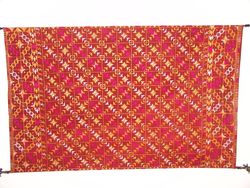
The historical region of Punjab is considered to be one of the most fertile regions on Earth. Both east and west Punjab produce a relatively high proportion of India and Pakistan's food output, respectively. The agricultural output of the Punjab region in Pakistan contributes significantly to Pakistan's GDP. The region is important for wheat growing. In addition, rice, cotton, sugar cane, fruit and vegetables are also major crops. Both Indian and Pakistani Punjab are considered to have the best infrastructure of their respective countries.[8] The Indian Punjab has been estimated to be the richest state in India.[9] The Pakistani Punjab produces 68% of Pakistan's food grain production.[10] Its share of Pakistan's GDP has historically ranged from 51.8% to 54.7%.[11]
Called "The Granary of India" or "The Bread Basket of India", Indian Punjab produces 1% of the world's rice, 2% of its wheat, and 2% of its cotton.[12] In 2001, it was recorded that farmers made up 39% of Indian Punjab's workforce.[13]
Timeline
- 3300 - 1500 BCE: Harappan civilization
- 1500 - 1000 BCE: Early Aryan (Rigvedic) Vedic civilization
- 1000 - 500 BCE: Middle and late Vedic Period
- 599 BCE: Birth of Mahavira
- 567 - 487 BCE: Time of Gautama Buddha
- 550 BCE - 600 CE: Buddhism remained prevalent
- 550 - 515 BCE: Achaemenid Invasion to west of Indus River
- 326 BCE: Alexander's Invasion of Punjab (part which is now in Pakistan)
- 322 - 298 BCE: Chandragupta I, Maurya period
- 273 - 232 BCE: Reign of Ashoka
- 125 - 160 BCE: Rise of the Sakas
- 2 BCE: Beginning of Rule of the Sakas.
- 45 - 180 : Rule of the Kushanas
- 320 - 550 : Gupta Empire
- 500 : Hunnic Invasion
- 510 - 650 : Vardhana's Era
- 950 - 1339: Lohara Dynasty, Kashmir
- 647 - 1192 : Rajput period
- 713 - 1300 : Muslim invaders (Turks and Afghans) including those by famous invaders Mohammed of Ghor and Mahmud of Ghazni
- 8th Century : Arabs capture Sind and Multan (currently in Pakistani Punjab) and join area to Abbasid Caliphate based in Iraq
- 1206 - 1290 : Mamluk dynasty establishes by Mohammad Ghori
- 1290 - 1320 : Khilji dynasty establishes by Jalal ud din Firuz Khilji
- 1320 - 1413 : Tughlaq dynasty established by Ghiyasuddin Tughlaq
- 1414 - 1451 : Sayyid dynasty established by Khizr Khan
- 1451 - 1526 : Lodhi dynasty establishes by Bahlul Khan Lodhi
- 1526 - 1707 : Mughal rule
- 1469 - 1539 : Guru Nanak Dev Ji (1st Sikh Guru)
- 1518 - 1565 : Mir Chakar Khan Rind
- 1539 - 1675 : Period of 8 Sikh Gurus from Guru Angad Dev Ji to Guru Tegh Bahadur Ji
- 1675 - 1708 : Guru Gobind Singh Ji (10th Sikh Guru)
- 1699 : Birth of the Khalsa
- 1708 - 1713 : Conquests of Banda Bahadur
- 1714 - 1759 : Sikh warriors (Sardars) struggle and perform warfare against Afghans & Mughal Governors
- 1739 : Invasion of Nadir Shah and warfare with Sikh Armies
- 1739- Durrani Empire
- 1760s- Durrani (Afghan empire)
- 1756 - 1759 : Sikh and Maratha Empire cooperation in the Punjab
- 1762 : 2nd massacre (Ghalughara) from Ahmed Shah's 2nd invasion
- 1761 - 1801 : Rule of the Sikh Misls (Confederacy)
- 1801 - 1839 : Rule by Maharaja Ranjit Singh
- 1843 - 1844 : First Anglo-Sikh War
- 1849 : Complete annexation of Punjab into British India
- 1849 - 1947: British rule
- 1947 : Partition of British India thus Punjab into 2 parts the Eastern part (or two rivers) became the Indian Punjab and the Western majority part (3 rivers) the Pakistani province of Punjab
- 1984 : Operation Blue Star. Battle between Indian military and Sikh militants at Amritsar Fort, the Golden Temple.
- 1985–present : Khalistan movemennt. The Khalistan Movement was deemed a Terrorist movement.
Photo gallery
.jpg) The Mughal-era Badshahi Mosque in Lahore |
 The Faiz Mahal, Khairpur, Pakistan |
 The fort at Bathinda |
 The main gate of the Qila Mubarak, Patiala |
|
The Golden Temple in Amritsar |
 The Alamgiri Gate built in 1673, is the main entrance to the Lahore Fort |
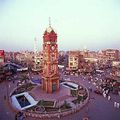 The clock tower in Faisalabad was built during the British Raj |
 The Phuara Chowk (lit. Fountain Crossing) in Patiala |
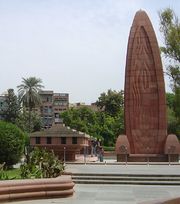 The memorial of the Jallianwala Bagh massacre |
 Jalandhar railway station reception block |
 Irrigated land in the Punjab |
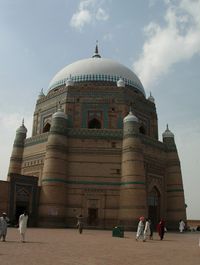 The mausoleum of Shah Rukn-e-Alam |
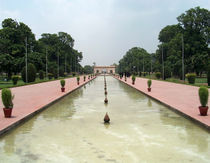 The Shalimar Gardens in Lahore |
 Mohindra College in Patiala |
 The Wazir Khan Mosque in Lahore |
The Hiran Minar in Sheikhupura, a tribute to Jahangir's favourite antelope |
 The mausoleum of Nur Jahan in Lahore |
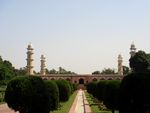 The mausoleum of Jahangir in Shahdara, Lahore |
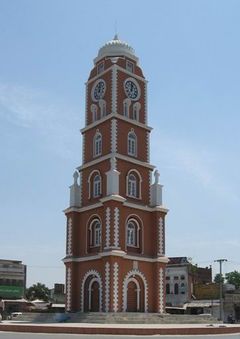 Sialkot Clock Tower, built during the British Raj |
 The Noor Mahal (Palace of Light) in Bahawalpur |
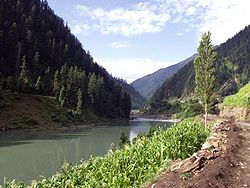 The Jhelum River, one of the major rivers of the Punjab |
The city of Chandigarh, capital of Indian Punjab |
See also
- Punjabi culture
- Punjabi language
- Punjabi cuisine
- Punjabi dance
- Music of Punjab
- Hinduism in Punjab
Further reading
- [Quraishee 73] Punjabi Adab De Kahani, Abdul Hafeez Quaraihee, Azeez Book Depot, Lahore, 1973.
- [Chopra 77] The Punjab as a sovereign state, Gulshan Lal Chopra, Al-Biruni , Lahore, 1977.
- Patwant Singh. 1999. The Sikhs. New York: Doubleday. ISBN 0-385-50206-0.
- The evolution of Heroic Tradition in Ancient Panjab, 1971, Buddha Parkash.
- Social and Political Movements in ancient Panjab, Delhi, 1962, Buddha Parkash.
- History of Porus, Patiala, Buddha Parkash.
- History of the Panjab, Patiala, 1976, Fauja Singh, L. M. Joshi (Ed).
References
- ↑ Singh, Pritam (2008). Federalism, Nationalism and Development: India and the Punjab Economy. London; New York: Routledge. pp. 3. ISBN 0415456665. http://books.google.com/books?id=mQLDcjhNoJwC.
- ↑ Pritam Singh and Shinder S. Thandi, ed (1996). Globalisation and the region: explorations in Punjabi identity. Coventry Association for Punjab Studies, Coventry University. p. 361.
- ↑ Indian Census
- ↑ http://maps.google.com/maps?f=d&source=s_d&saddr=Chandigarh,+India&daddr=Lahore,+Punjab,+Pakistan&hl=en&geocode=FVHs1AEd2X-TBClryW7mC-0POTH-GXNS-Wf_pQ%3BFdpW4QEdS1luBCnZB4HlgwQZOTFiJH7MbL46wg&mra=ls&sll=31.140085,75.557775&sspn=1.30467,2.897644&ie=UTF8&z=9&pw=2
- ↑ Buddha Parkash, Evolution of Heroic Tradition in Ancient Panjab, p 36.
- ↑ History of Panjab, Vol I, p 4, Dr L. M. Joshi, Dr Fauja Singh.
- ↑ "Census Reference Tables, C-Series Population by religious communities". Census of India. 2001. http://censusindia.gov.in/Census_Data_2001/Census_data_finder/C_Series/Population_by_religious_communities.htm. Retrieved 2010-07-25.
- ↑ Welcome to Official Web site of Punjab, India
- ↑ "Punjab second richest state in country: CII", Times of India, 8 April 2004.
- ↑ Pakistani government statistics, retrieved 14 April 2007.
- ↑ Provincial Accounts of Pakistan: Methodology and Estimates 1973-2000
- ↑ Welcome to Official Web site of Punjab, India
- ↑ Punjabi government statistics, retrieved 14 April 2007.
External links
- Indian Punjab Government Website
- Punjabi News Website
- Pakistani Punjab Government Website
- The Genetic Heritage of the Earliest Settlers Persists Both in Indian Tribal and Caste Populations
- Punjabi Art
|
|||||
|
|||||||||||